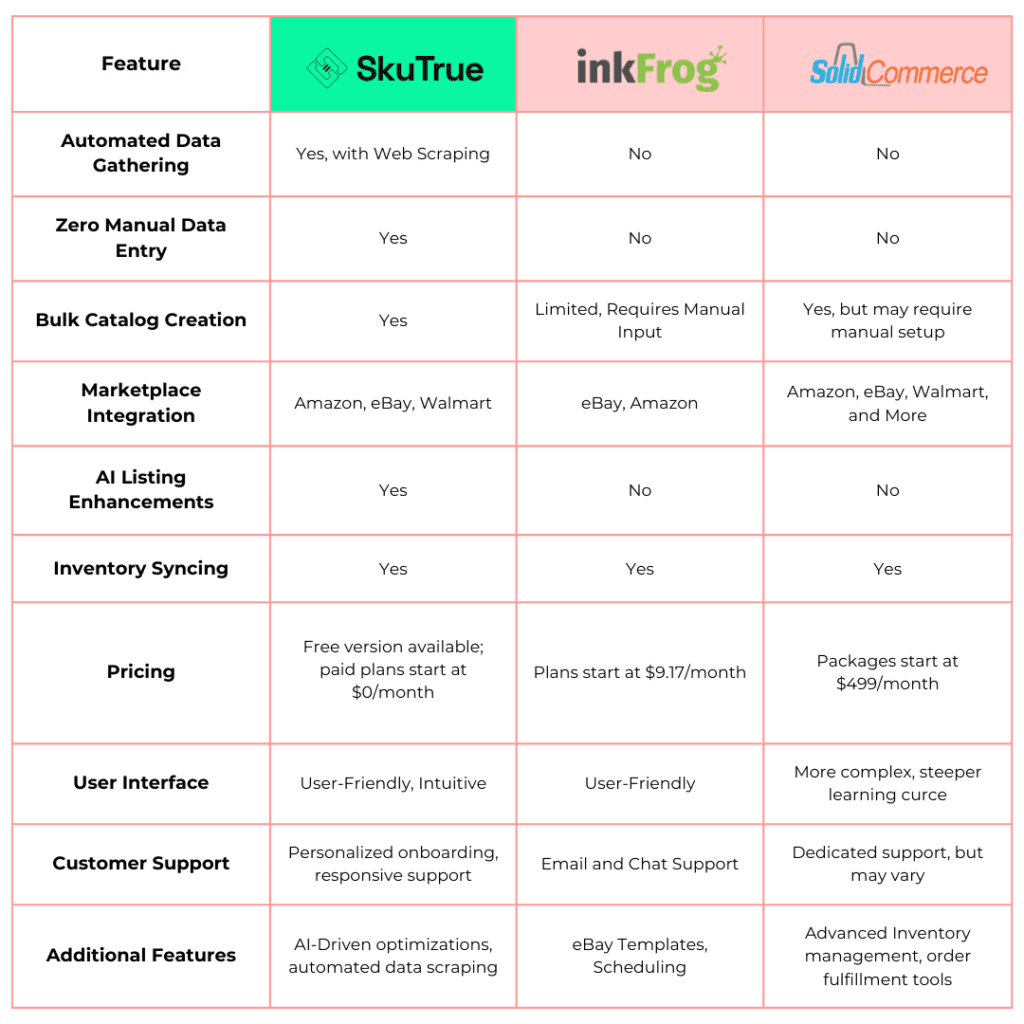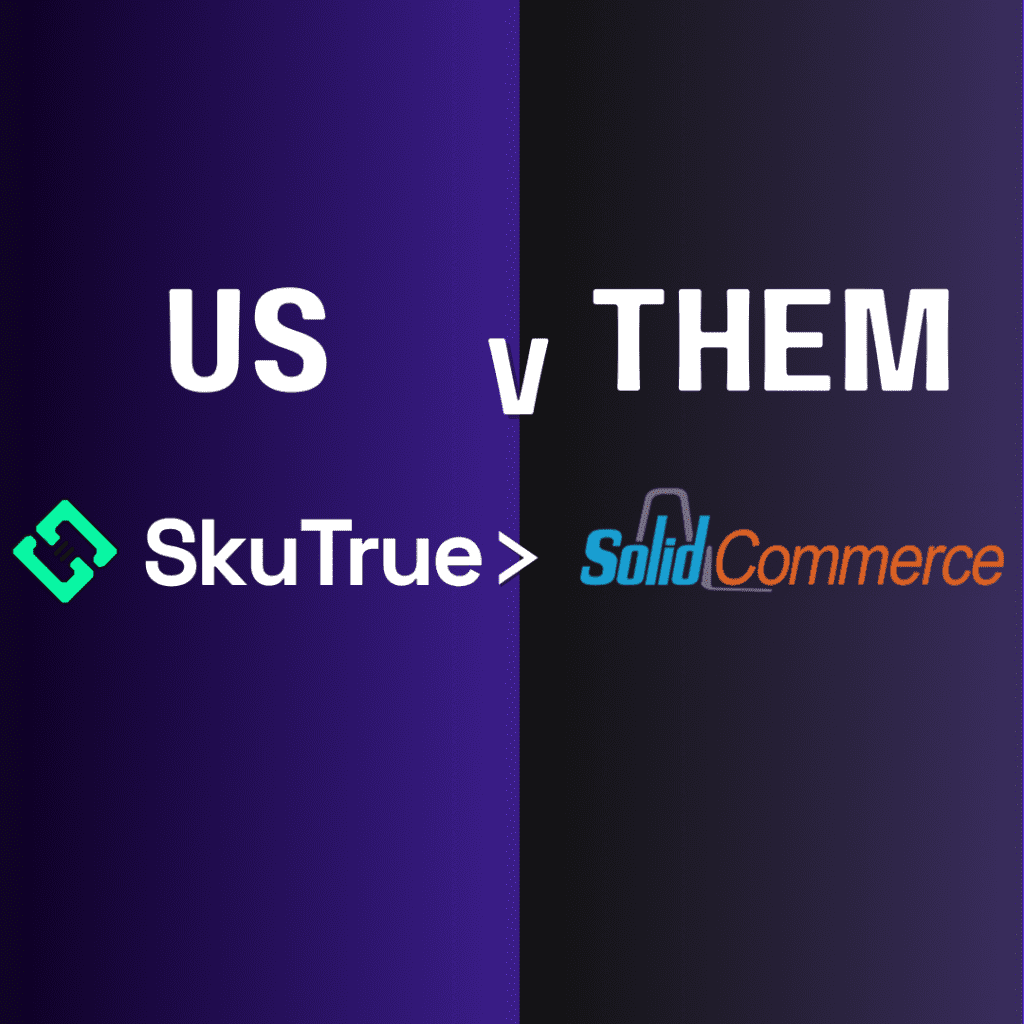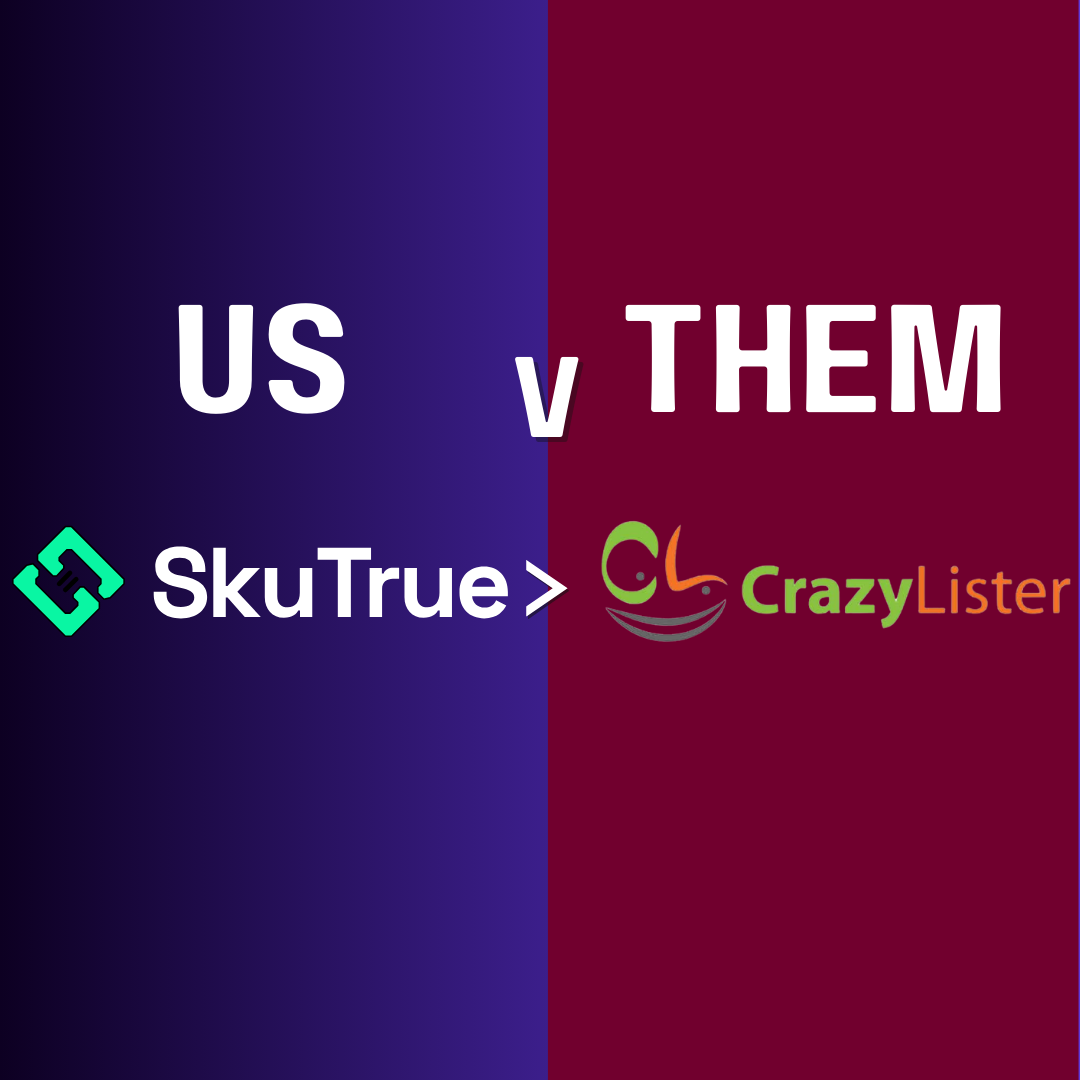When it comes to managing product listings across multiple marketplaces, both SkuTrue and Solid Commerce provide robust solutions. However, these tools cater to different business needs. Solid Commerce is well-suited for large, enterprise-level businesses needing extensive inventory control and fulfillment features, while SkuTrue targets small to mid-sized eCommerce sellers focused on automation, zero-manual data entry, and easy scalability.
We’ve broken down the key differences between SkuTrue and Solid Commerce to help you identify which tool is best for your eCommerce goals.
Key Features Comparison: SkuTrue vs. Solid Commerce

1. Automated Data Gathering with Web Scraping
SkuTrue Advantage: SkuTrue offers automated data gathering via web scraping, a feature that captures essential product information automatically—no manual data entry required. This unique capability makes SkuTrue an efficient choice for data-driven sellers. Solid Commerce lacks this feature and relies on manual data input or importing from files, which may slow down setup.
2. Zero Manual Data Entry
SkuTrue Advantage: SkuTrue is designed for sellers looking to eliminate manual work entirely. With zero-manual data entry, there’s no need for tedious taxonomy mapping or template setup. In contrast, Solid Commerce requires additional manual steps, which can add complexity and setup time
3. Bulk Catalog Creation
SkuTrue Advantage: SkuTrue supports bulk catalog creation, allowing 500+ SKUs to be listed with a single click. This is ideal for sellers with large inventories looking to scale quickly. While Solid Commerce also supports bulk uploads, it often requires some manual setup, making SkuTrue the more straightforward choice for high-volume listings.
4. Marketplace Integration: Amazon, eBay, and Walmart
Both Platforms Offer: SkuTrue and Solid Commerce each integrate with Amazon, eBay, and Walmart, covering major marketplaces for eCommerce sellers. Solid Commerce extends support to other platforms like Jet, Shopify, and BigCommerce, which could be advantageous for sellers managing multiple niche channels.
5. AI-Powered Listing Enhancements
SkuTrue Advantage: SkuTrue’s AI-driven listing enhancements are designed to optimize product titles, descriptions, and other details automatically, improving visibility and performance on Amazon, eBay, and Walmart. Solid Commerce lacks this feature, making SkuTrue the choice for sellers who want to boost listing effectiveness through automation.
6. Inventory Synchronization
Both Platforms Offer: Both SkuTrue and Solid Commerce provide real-time inventory synchronization across connected marketplaces, ensuring accurate stock levels and preventing overselling. This feature is essential for multi-platform sellers looking to keep their inventory up-to-date across various channels.
Pricing Comparison
- SkuTrue: SkuTrue offers a free version with paid plans starting at $0/month, providing a cost-effective solution for small and mid-sized businesses.
- Solid Commerce: Solid Commerce packages start at $499/month, targeting larger, enterprise-level businesses that require advanced inventory management and fulfillment features.
With SkuTrue’s lower-cost options, it’s an affordable choice for budget-conscious businesses. Solid Commerce’s higher pricing reflects its extensive features and enterprise focus.
User Experience and Support
- SkuTrue: Known for its user-friendly interface, SkuTrue offers personalized onboarding, one-on-one training, and responsive support, making it ideal for smaller teams or new sellers.
- Solid Commerce: While feature-rich, Solid Commerce has a steeper learning curve. It offers dedicated support, but response times and personalized assistance may vary depending on the plan.
For users who prioritize ease of use and accessible support, SkuTrue is the better option.
SkuTrue and Solid Commerce each bring unique advantages to eCommerce management. For sellers needing comprehensive inventory control and multiple platform connections, Solid Commerce’s features suit larger, enterprise-level businesses. However, for small to mid-sized businesses prioritizing streamlined processes, automation, and AI-driven optimizations, SkuTrue stands out as the best choice.
Choose SkuTrue if you’re a growth-focused seller who values efficiency and low-maintenance setup. If you run a large-scale operation with more complex needs, Solid Commerce may be the ideal solution.
FAQs: Why SkuTrue Stands Out Over Solid Commerce
Q: How does SkuTrue’s automated data gathering compare to Solid Commerce?
A: SkuTrue’s unique automated data gathering uses web scraping to pull product information automatically, eliminating manual entry and saving time—something Solid Commerce does not offer.
Q: Is manual setup required with SkuTrue?
A: No. SkuTrue is designed with zero-manual data entry, so you won’t need to map taxonomy or set up templates. Solid Commerce, however, requires more manual steps in setup, which can be time-consuming.
Q: How does SkuTrue’s bulk catalog creation feature differ from Solid Commerce’s?
A: SkuTrue allows users to upload 500+ SKUs at once with one click, a highly efficient option for scaling. While Solid Commerce supports bulk uploads, it may require additional manual mapping and adjustments.
Q: What advantage does SkuTrue’s AI-powered listing enhancement offer?
A: SkuTrue uses AI to optimize titles, descriptions, and other details, enhancing listing visibility and performance automatically. Solid Commerce lacks this feature, making SkuTrue ideal for sellers wanting improved listing effectiveness without manual adjustments.
Q: Is SkuTrue suitable for small businesses?
A: Yes, SkuTrue’s affordable pricing, automated features, and user-friendly interface make it an excellent choice for small to mid-sized eCommerce businesses looking to streamline their operations.


